This pizza sauce recipe from fresh tomatoes utilizes your garden crop. Flavored with herbs and spices, it will make your homemade pizza just that much better.
Be sure to try our favorite pizza dough recipe!
Making pizza sauce from scratch
Making your own pizza sauce recipe starts with tomato puree that’s cooked down to the texture and thickness that you like in a pizza sauce. Let’s talk first about how to make the puree.
If (like me) you are starting with a juicier slicing tomato, you’ll need to cook the mixture down until it reaches the appropriate consistency for topping pizza. My most recent batch required reducing the original amount of tomatoes by about half.
The Handcrafted Pantry

Ready to DIY your pantry with more wholesome ingredients? Check out my ebook, The Handcrafted Pantry! Filled with delicious recipes for some of your favorite condiments, snacks, and toppings, it’s the guide you need to start skipping packaged products and embrace homemade.
Ingredients
Tomatoes — You can use any variety of tomato, but if you choose a very juicy variety, you’ll need to cook the sauce down longer to thicken it. Paste tomatoes are a great option since they’re so meaty. Fresh from the garden tomatoes will always provide the best flavor.
Bell pepper — Adding finely chopped red bell pepper to this pizza sauce adds flavor and a bit of sweetness.
5 Easy Steps to Transform Your Pantry!
Ready to switch from store bought to homemade? Let me help you make some changes! Grab my FREE five-part guide to getting started.
Onion — This recipe calls for red onion. I prefer its sweetness, but you can use any kind of bulb onion you have on hand — white, yellow, or red.
Seasonings — The various herbs and spices included in this recipe are what give it the classic pizza flavor. In addition to salt and black pepper, use dried basil, oregano, savory, and red pepper flakes for a bit of heat. Avoid adding fresh herbs, as this can alter the pH of the sauce.
Sweetener — Granulated sugar (I prefer organic) helps tone down the acidity. If you’d prefer, you can use honey.
Citric acid — This is one of those ingredients that you may not have on hand. I’ve used this rather than lemon juice as extra acid to generate the necessary pH for safe canning, to avoid adding more liquid to the recipe. You can order citric acid here or substitute one tablespoon of bottled lemon juice in each jar.
Preparing the fresh tomatoes
There are a couple of ways to do this. The first thing to consider is if you are bothered by seeds or tomato skins in your sauce or not.
If the answer is no, there’s no need to peel them. You can simply puree the fruit in a food processor or blender. If you remove some of the seedy pulp before you do, you’ll eliminate a fair amount of liquid. This means it will take less time to cook down.
If you’d prefer not to have seeds in the sauce, run the pureed tomatoes through a food mill, food strainer, or chinois. This will remove the seeds and skin. [More on using a food mill here.]
Once the tomato purée is prepared, you’ll bring the mixture to a boil in a large stockpot. If necessary, cook the mixture down until it’s a good consistency. Depending on how much liquid was in your fresh tomatoes, this can take a couple of hours.
Since I like my pizza sauce recipe to result in a thick sauce, I cook the fresh tomatoes down until the sauce begins to bubble and splatter a bit.
Adding herbs and spices
When the sauce is the right consistency, add the red bell pepper, onion, garlic, herbs, and spices and cook for another ten minutes or so. Note that the “right consistency” is a little subjective. Some people like a thinner sauce, some like it thicker. You do you!
If you’d like the sauce to be especially smooth, you can use an immersion blender to puree the veggies even more finely.
At this point, you have successfully made your own homemade pizza sauce recipe! Use it immediately, refrigerate it for up to a week, or take it a step further to make a home canned pizza sauce.
You can freeze the sauce in freezer containers or mason jars as well, though you may note some separation upon thawing. To remedy this, reheat the pizza sauce and cook to eliminate excess liquid.
🍅 Safety First!
Canning is an excellent way to preserve food for the pantry, but there are some important safety considerations to keep in mind. The recipes on this site have been made following safe canning procedures by a certified Master Food Preserver.
- Know the difference between water bath canning and pressure canning. Low acid items must be pressure canned for safety.
- Altering ingredients may change the recipe’s pH, posing a safety issue. I highly recommend investing in pH paper to test your products for acidity level when canning. Note: For safe water bath canning, the Hawaii Master Food Preservers suggest a pH of 4.2 or lower in the tropics. In other regions, the recommended pH is 4.6 or lower.
- Use the proper jars and lids. Never reuse lids, with the exception of the Tattler or Harvest Right hard plastic lids that are intended for such a purpose.
- For more on canning equipment, please go here.
- Want to learn more? The National Center for Home Food Preservation is the go-to resource for safe canning information.
How to make pizza sauce shelf stable
Canning pizza sauce in a water bath canner makes it a shelf stable product that can last a year in the pantry. Be sure to read this guide to canning tomatoes before you start.
Prepare the Canning Pot
Fill a large canner with water. Just how much takes a little bit of guesswork. Use enough water that the full jars will covered by an inch or two of water during processing. Adding the full jars to the water will cause the water level to rise; how much depends on how many jars you’re processing at once. Most canners will hold seven jars at a time, but you can process fewer than that if you don’t have a full load.
Jarring the Sauce
You’ll need special glass jars made for canning, flat lids, and rings to make this a shelf-stable product. You can use pint or half pint jars.
To prepare, wash jars in warm water. I like to place jars in the water bath canner as it heats to keep them warm. This lessens the risk of breakage when transferring the hot jam into the jars.
Fill the empty jars with jam, leaving a quarter-inch headspace. Wipe the rims of the jars, removing any residue. Place the lids on and process them in a water bath canner. What this means is you’ll put the filled and sealed jars of jam into boiling water and heat them for ten minutes. This assures that the jars will seal well and kills off any potential bacteria in the jam mixture itself.
Use a jar lifter to remove the hot jars from the canner and place on a towel-covered countertop; allow to cool fully. As they cool, you’ll hear the little “tink” sound of the jars sealing. Store any unsealed jars in the fridge and use those first. (This is unusual, but it does happen once in awhile.)
Once the sauce is ready, ladle it into pint or half pint jars while it’s still hot. I have a canning funnel for this purpose, that makes it easier to transfer the sauce into the jars without a lot of mess.
Use a damp cloth to wipe the rim of each jar; a little bit of food on the jar rim can prevent the lids from sealing properly. Set the lids in place and screw the bands on finger tight. Use a jar lifter to transfer hot jars into the gently boiling water. As stated above, the water in the pot should cover the jars by an inch. If necessary add more water to the canner.
Process jars for the recommended time. (See below.) When time is up, use the jar lifter to transfer jars to a flat surface that’s padded with a kitchen towel. Allow jars to cool completely. As they cool, you’ll begin to hear a canner’s favorite sound: That lovely little tink! that indicates a successful seal.
Once jars of pizza sauce are thoroughly cooled, check the seal on all of the jars. The lid should be concave and solid. If it flexes at all, it’s not sealed. (Place any jars that didn’t seal in the refrigerator and use them first. They are not shelf stable.)
Remove bands from cooled jars and rinse the jars. Store jars without the bands.
★ Did you love this recipe? Be sure to give it a star rating below! ★
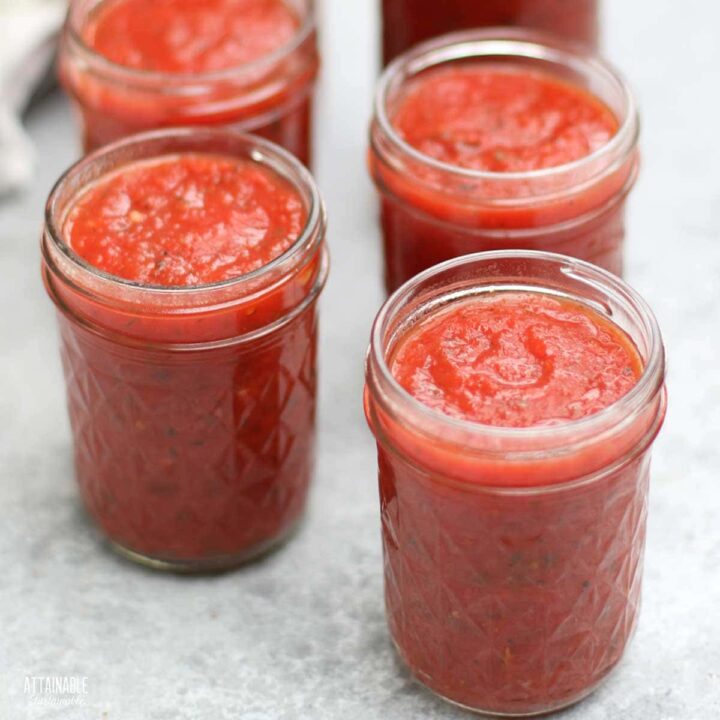
Homemade Pizza Sauce from Fresh Tomatoes
This recipe for pizza sauce starts with fresh tomatoes for a garden fresh topping! Make up a batch and can the sauce for the pantry or use it right away.
Ingredients
- 9 cups tomato puree (see instructions)
- 1/2 large red bell pepper, finely chopped
- 1/2 medium red onion, finely chopped
- 1 teaspoon salt
- 1/2 teaspoon pepper
- 1 teaspoon basil
- 2 teaspoons oregano
- 2-1/2 teaspoons savory
- 1/8 teaspoon red pepper flakes
- 2-4 tablespoons sugar
- citric acid (1/4 teaspoon per pint jar)
Instructions
Make the tomato puree:
- Wash and dry fresh tomatoes. Roma tomatoes are a good option, but any type of tomato can be used.
- Chop tomatoes and run through a food mill or chinois to remove seeds. Alternatively, use a food processor or blender to puree the fruit.
- Cook over medium high heat stirring frequently until the puree reaches desired consistency, stirring occasionally to make sure it doesn't stick to the bottom of the pot. This will depend on the level of moisture in the fresh tomatoes.
Make the pizza sauce
- Measure 9 cups of the prepared tomato puree, bell pepper, and onion into a large stock pot. Cook at a slow boil for 10 minutes.
- Add remaining ingredients and cook for another 10 minutes.
- Cool and refrigerate for up to a week, or continue with instructions for canning a shelf stable pizza sauce.
Prepare for canning
- Wash the jars you'll use, making sure each is clean and free of nicks in the rim, which could impede sealing.
- Wash the lids and rings in hot soapy water. (If you're using non-Ball brand lids, prepare as suggested by manufacturer.)
- Place empty jars in a canning pot or large stock pot with enough water to cover by an inch or two, cover pot, and set on high heat. It can take awhile for the water to heat, so get it started before you begin making the recipe.
Canning the pizza sauce
- While the pizza sauce is cooking, fill a canning pot with water, set the lid in place, and heat on high heat until boiling.
- Bring a small saucepan of water to a simmer, turn off heat, and place jar lids and rings in the water to sanitize them.
- Measure 1/4 teaspoon of citric acid into each pint sized jar.
- Ladle hot sauce into pint or half-pint jars, leaving 1/4" head space. A canning funnel makes this easy.
- Wipe jar rims to remove any sauce that may have spilled. A clean rim is essential to a good seal.
- Set jar lids in place. Screw bands on finger tight.
- Use a jar lifter to gently submerge jars into hot water in canning pot. Water should cover the top of the jars by an inch. The water will cool somewhat in reaction to the addition of the jars. Return the water to a simmer and set the timer.
- Process for 35 minutes 0-1,000 feet altitude; 40 minutes, 1,001-3,000 feet altitude; 45 minutes, 3,001-6,000 feet; 50 minutes over 6,000 feet.
Notes
I started with 8 pounds of tomatoes, which netted about 15 cups of tomato puree. I cooked this down until it was desired consistency, resulting in 9 cups of thick puree suitable for making pizza sauce.
Note that the cook time indicated above will vary depending upon the juiciness of the tomatoes you use.
I opted to use citric acid rather than lemon juice to avoid adding excess liquid. If you prefer, you can use 1 tablespoon of lemon juice in each pint sized jar.
If you would prefer to process this recipe in a pressure canner, process half-pints or pints for 15 minutes as follows:
Dial gauge canner: 11 pounds up to 2,000' elevation; add one more pound for every 2'000' increase in elevation.
Weighted gauge canner: 10 pounds up to 1,000' elevation; 15 pounds over 1,001' elevation.
Boiling lids or heating above 180°F as once recommended can damage the sealing compound.
SOURCE: Adapted from the United States Department of Agriculture (USDA) Complete Guide to Home Canning, page 3-13, altering the dry spices as allowed in safe canning.
Nutrition Information:
Yield: 16 Serving Size: 1/4 cupAmount Per Serving: Calories: 69Total Fat: 0gSaturated Fat: 0gTrans Fat: 0gUnsaturated Fat: 0gCholesterol: 0mgSodium: 172mgCarbohydrates: 17gFiber: 3gSugar: 10gProtein: 2g
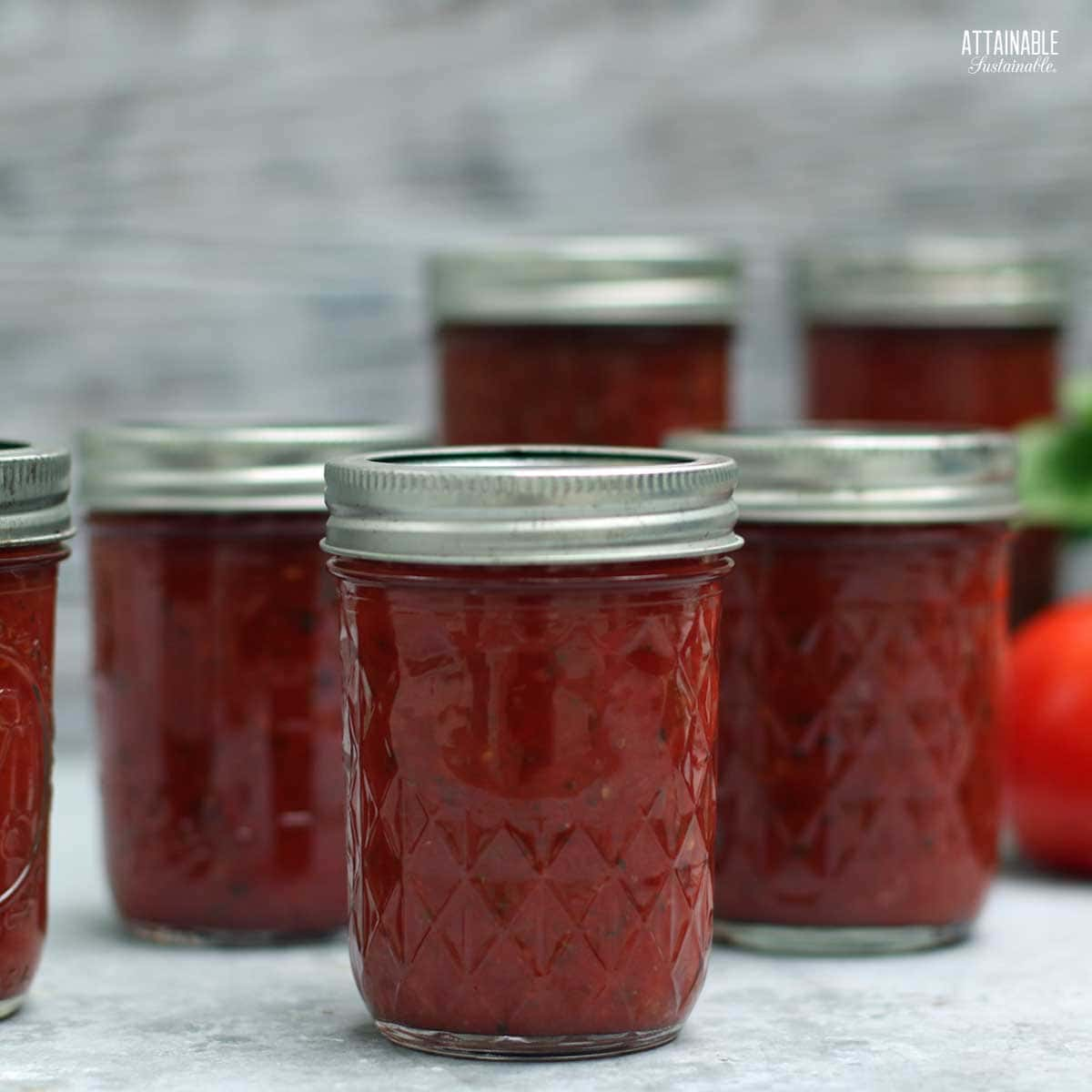
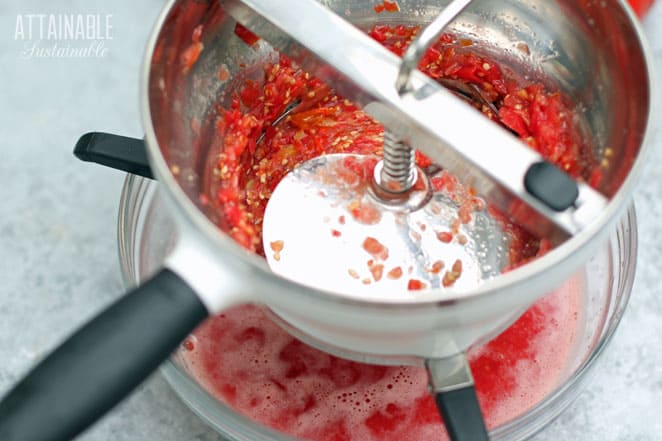
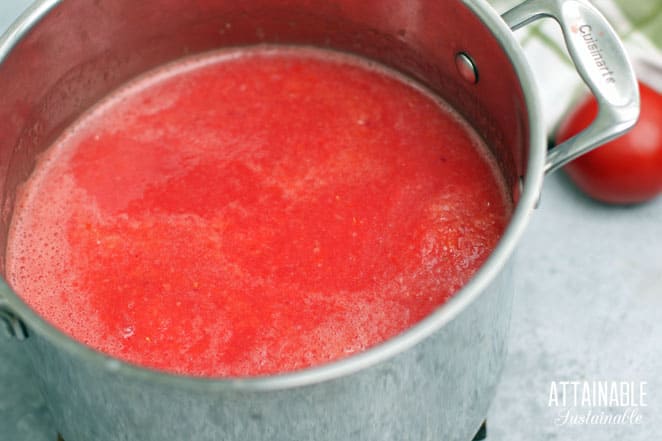
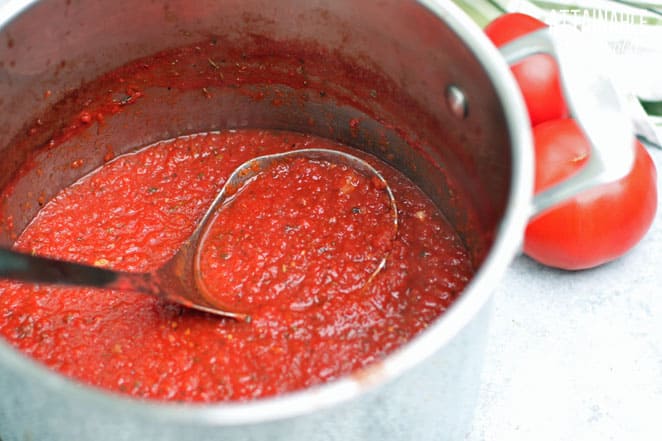
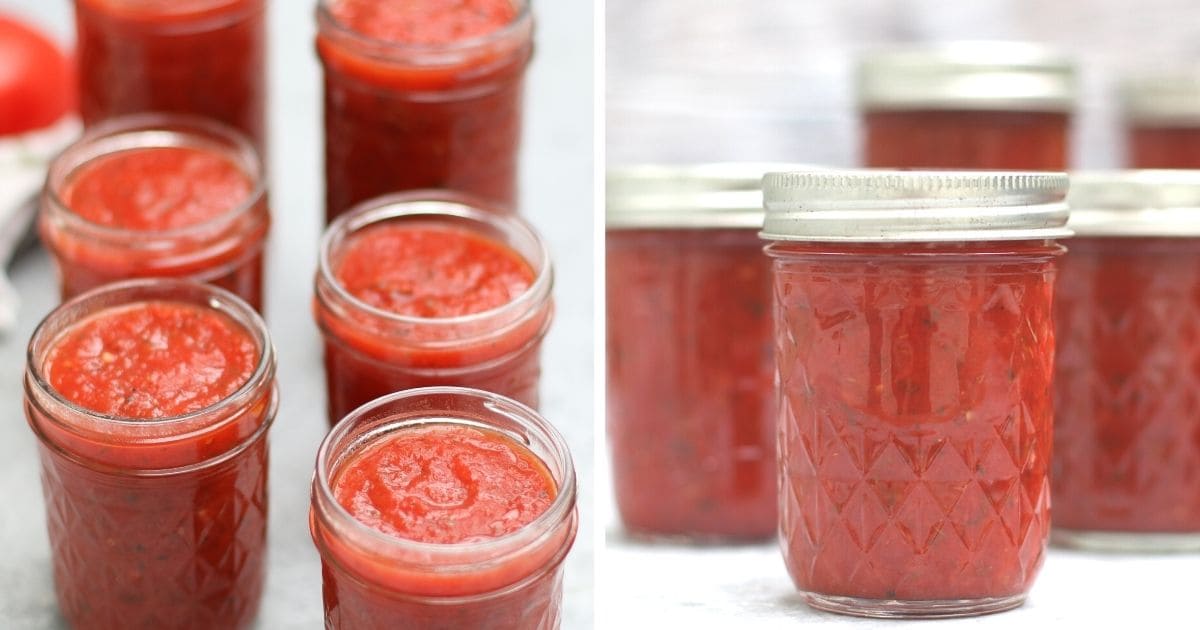
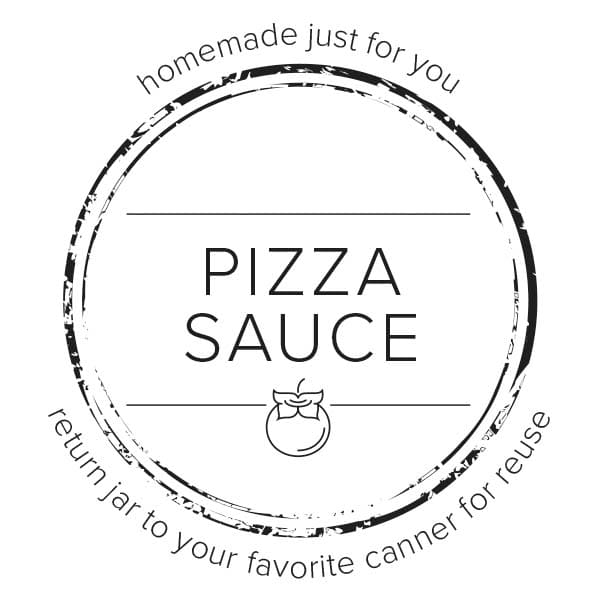
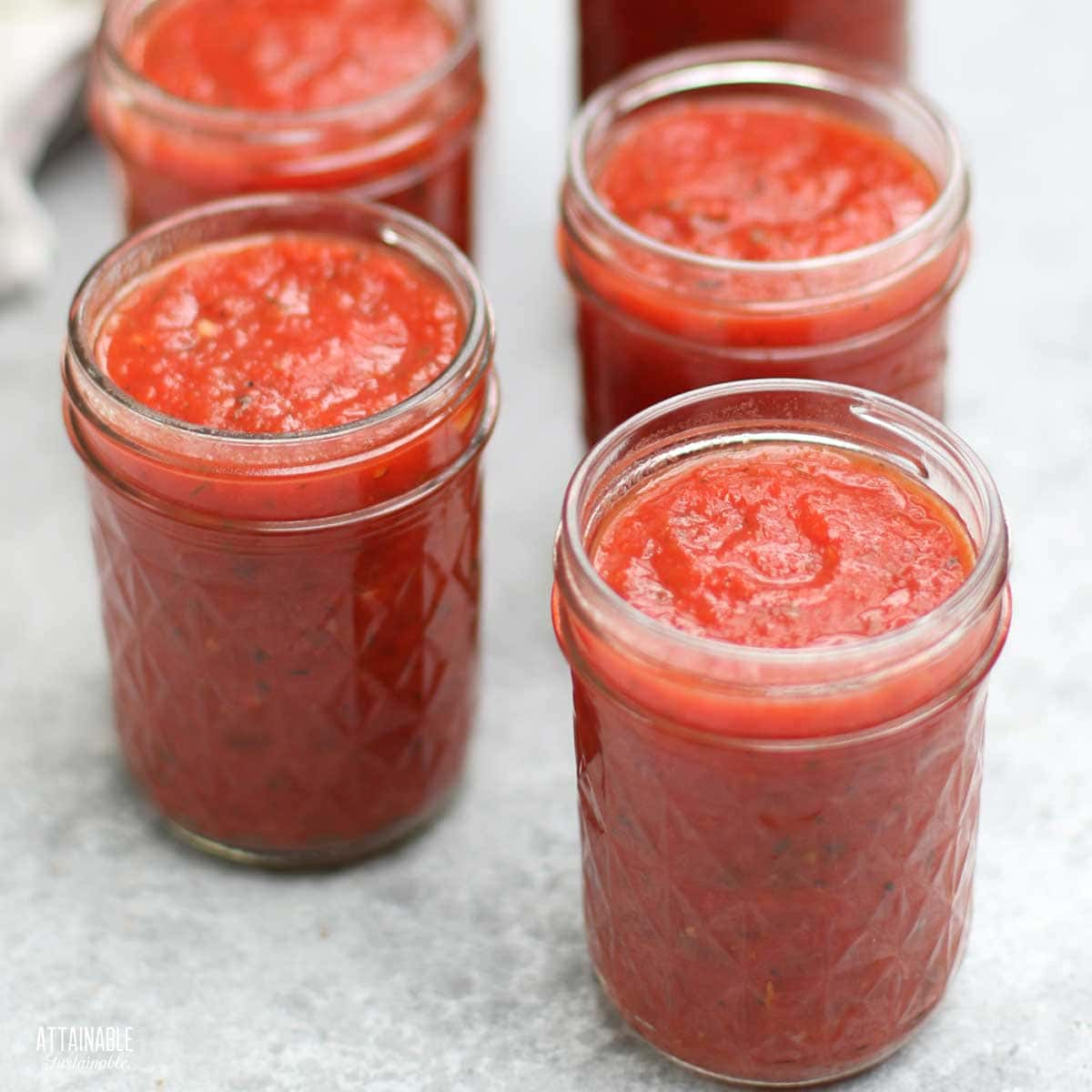
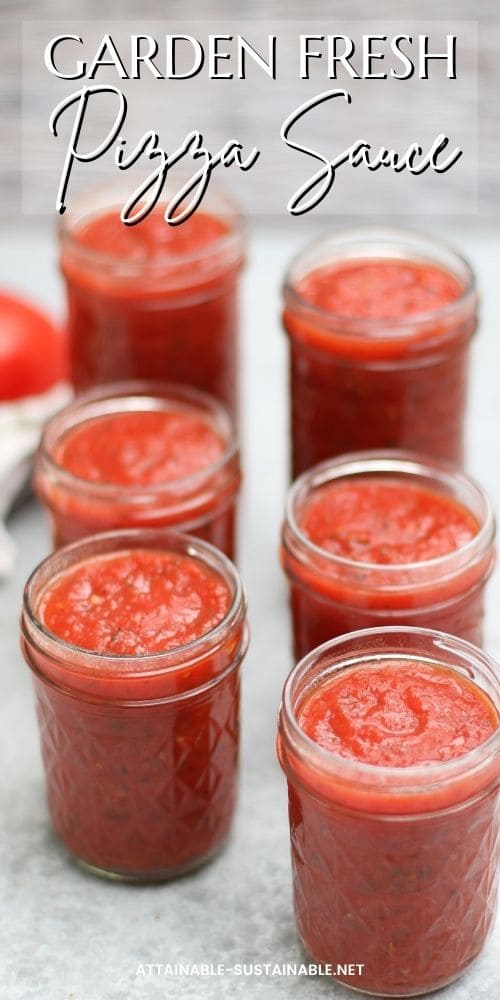
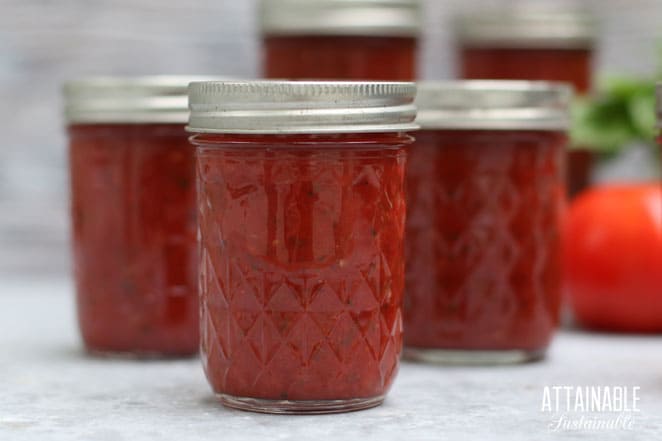





Ok, maybe I missed how many tomatoes you need to make 9 cups of puree. Can you possibly state how many, please?
Thank you
I used 8 pounds of tomatoes, making about 15 cups of tomato puree. I cooked this down to the desired consistency, resulting in 9 cups of thick puree.
Hi! I can’t wait to try your recipe. I wanted to use half pint jars though. How long would I process those? And I’m assuming I would add 1/2 T of lemon juice to each jar. Thanks!
You can always use smaller jars safely, but they need to be processed for the time called for originally. (You can’t safely increase jar size.) And yes, halve the acid.
Hi, are all of the herbs in this dried? Thank you!
Yes, I avoid adding fresh herbs for canning this pizza sauce, as they can alter the pH of the sauce. If not canning, you could do either.
This looks so good! What a great way to use garden tomatoes!
Can you freeze this rather than can it?
You can freeze the sauce in freezer containers or mason jars as well, though you may note some separation upon thawing. To remedy this, reheat the pizza sauce and cook to eliminate excess liquid.
can i freeze this instead
Yes! Freeze the sauce in freezer containers or mason, though you may note some separation upon thawing. Reheat the pizza sauce and cook to eliminate excess liquid.
So I just opened a jar of pizza sauce that I made last fall. And it might be the best thing I’ve ever made! Thank you so much for this recipe! This is on the list to make every year now. I’m even planning on giving Pizza gift baskets for a few people next year – jars of pizza sauce, a pizza stone, a pizza cutter and a cute pair of oven mitts as Christmas gifts. Thanks again for such a great recipe!
What a great idea! So happy you love the sauce!
Not a bell pepper fan. Does it need to be in there or is there a substitute?
You can safely omit the pepper.
Do you remove the skins first?
Either way is ok, it depends on what you prefer.
I use a crockpot rather than a large stockpot to cook down my tomatoes. After washing my tomatoes, I cut them into pieces, put them in the crockpot on High with the lid ON, and cook them until they are soft (1-1 1/2 hrs.). When soft, I use my food mill to remove seeds and skins. I wipe out my crockpot, put the purée and other ingredients (chopped) back into the crockpot on High with the lid OFF. Let it reduce by half. I would use my immersion blender to mix and smooth the sauce. The crockpot minimizes watching the sauce as it cooks and prevents burning.
Thanks for sharing your method!
If I were to can using a pressure cooker, what would you recommend for the pressure and processing time?
This is a water bath canning recipe, but if you’d like to pressure can it, you can. Weighted gauge canner: 5 lbs up to 1,000′ elevation, 10 pounds above 1,000′. Dial gauge: 6 pounds up to 2,000′ elevation and add one pound of pressure for every 2k increase in elevation.
Note that it is not safe to can in a pressure COOKER; you need a special pressure CANNER. Not sure if you’re calling it one thing and meaning another, but wanted to be clear!
What pressure in the canning process. 10lbs?
This is a water bath canning recipe, but if you’d like to pressure can it, you can. Weighted gauge canner: 5 lbs up to 1,000′ elevation, 10 pounds above 1,000′. Dial gauge: 6 pounds up to 2,000′ elevation and add one pound of pressure for every 2k increase in elevation.
Roughly how many tomatoes are you using to make 9 cups of puree?
I used 8 pounds, I’m not sure how many tomatoes it was by count. It would vary depending on which type of tomatoes, so going by weight will work best.
I added a little garlic salt after tasting. It tasted better to me after that. I am going add fresh minced garlic when I make it again. I did not have savory on hand so maybe that’s what was missing. I did add thyme in its place.Thanks for sharing your recipe.
That’s a good improvise, I’m glad it worked out! 🙂
I have not heard of the ingredient savory before. Where would that be found?
Savory is a spice that you should be able to find wherever you buy your spices. If not, thyme will work as a substitute!
Can this recipe be frozen?
Yes! Although you may notice some separation when you thaw it. To remedy this, reheat the pizza sauce and cook to eliminate excess liquid.